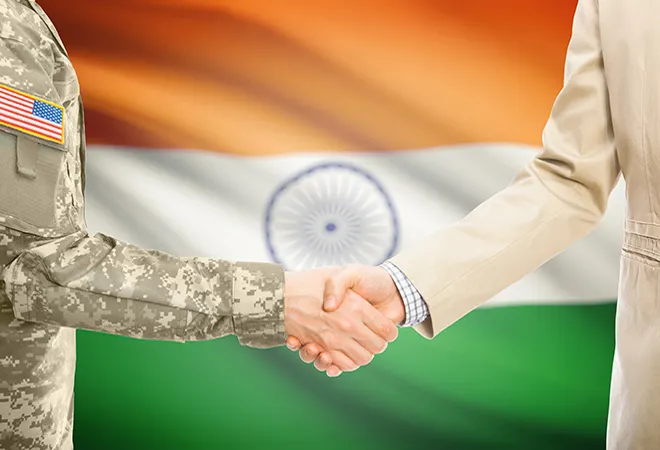
This September, eight Boeing AH-64E(I) Apache Guardian Helicopters are expected to be formally inducted into the Indian Air Force. Currently undergoing flight-testing at the Hindon Air Force Station on the outskirts of New Delhi, the attack helicopters — often deemed to be “tanks in the air” — were delivered ahead of schedule in two batches on 27 and 30 July. Part of the USD 1.4 billion deal inked in 2015 for 22 Apache helicopters, the delivery came at a time when certain US apprehensions over its ties with India have come to the fore.
Trade talks are proving inconclusive and there have been rounds of retaliatory tariffs. India’s purchase of Russian S-400 missile defence systems continues to invite American ultimatums ahead of its scheduled delivery in 2020. Finally, US-India ties recently took a hit when President Trump’s transactionalism on seeking Pakistani cooperation on the ongoing US-Taliban talks over post-conflict Afghanistan ended up appearing to internationalise the Kashmir issue.
Nonetheless, as the delivery of the Apaches illustrates, US-India defence ties appear to be developing unhindered. This is in large part because Pentagon is pursuing strategies that owe little or nothing to the Trump administration’s political instincts.
Pentagon thinking on US-India ties
The Trump administration's ‘America First’ view rests upon a commitment to the use of untrammeled economic and military hard power. There is a visible disdain for multilateralism and the White House seems to have abandoned the commitment to democratic nation-building championed by earlier administrations.
The Trump administration’s focus on China’s emergence as the principal strategic competitor to US primacy, has however, triggered a Polanyian “double movement” leading the administration and government agencies away from populist nationalism and towards some policy ideas that resemble erstwhile Republican neoconservatism.
India has acquired even greater importance in DoD thinking and it has, together with some other parts of the US federal government, pulled the White House along.
The Department of Defense (DoD) has played a noteworthy part in this. Notwithstanding the administration’s many twists and turns, the Pentagon has embraced the demand for a Free and Open Indo-Pacific (FOIP). It has steadfastly insisted that the region is its “priority theater”, and in its June 2019 Indo-Pacific Strategy Report reiterated the importance of regional multilateralism by calling for “a more robust constellation of allies and partners.” Much of this goes against Trumpian instincts.
Within this context, India has acquired even greater importance in DoD thinking and it has, together with some other parts of the US federal government, pulled the White House along.
In the DoD’s calculus, India is represented together with Japan as cornerstones within FOIP. In many ways, the aim is to ‘socialise’ India into the role of a regional guardian. If India took on such a role, it would also, according to some American commentators, allow the focused deployment of crucial US naval assets to the South and East China Seas.
Thus, although Trump’s politics represent a sharp break with the past, there is policy continuity if DoD strategies are considered. On top of this, there is an awareness of the economic potentialities offered by India’s large arms market. On this, there is a “fit” between the DoD calculus on India and the Trump administration’s push for greater arms exports and spread of American technological ingenuity.
Unhindered impetus to US-India defence interoperability
The Carter mantra, an unofficial dictum informing the US’ approach to India named after former US Secretary of Defense Ashton Carter, calls for the US to focus on strategic ties, and prevent differences on avenues like trade from crowding out minimal-yet-positive developments.
Under Trump, the Carter mantra has often come under strain, either over long-standing trade issues such as India’s insistence on price caps for pharmaceutical imports, or strategic incompatibilities like India’s historically-strong energy ties with Iran. However, given the Pentagon’s apparent lead of the India portfolio, the tempo of US-India defence interoperability has been unhindered.
In the final months of the Obama administration, the US and India signed the Logistics Exchange Memorandum of Agreement (LEMOA) in 2016 – an India-specific modified version of the Acquisition and Cross-Servicing Agreement (ACSA). The same facilitated “basic terms, conditions, and procedures for reciprocal provision of logistic support, supplies, and services between the armed forces of India and the United States.”
Given the Pentagon’s apparent lead of the India portfolio, the tempo of US-India defence interoperability has been unhindered.
Thereafter, one year into the Trump administration, in 2018, the US and India signed the second defence interoperability pact — the Communications Compatibility and Security Agreement (COMCASA). An exclusive India-specific tailored version of the Communication and Information on Security Memorandum of Agreement (CISMOA), the same was aimed at facilitating “access to advanced defense systems and enable India to optimally utilize its existing US-origin platforms.”
Less than a year since then, reports suggest American and Indian defence officials are now working towards finalising differences over inking the final US-India defence interoperability agreement — the Basic Exchange and Cooperation Agreement (BECA), for mutual access of geospatial maps.
Seeking an active New Delhi in the Indo-Pacific calculus
This impetus to defence interoperability often figures in the fact that India now conducts “more joint military drills, tabletop exercises, and defense dialogues with the US than with any other country, which include more than 50 ‘cooperative events across all Services’ annually.” These efforts seem to be aimed at India’s slow acclimatisation to the interconnected destinies of the Indian Ocean region and the Western Pacific.
A testament to the effort came early this year in May, when the Indian Navy joined the navies of the US, the Philippines, and Japan for a Group Sail in the South China Sea.
This year alone, the US has cleared or raised the prospect of exporting to India numerous platforms. Some of notable mention include, 777 Large Aircraft Infrared Countermeasures Self Protection Suites, SIG 716 Assault Rifles, MH-60 Romeo Seahawk Anti-Submarine Helicopters, National Advanced Surface to Air Missile System-II, and Sea Guardian Drones — the naval version of the Predator B armed done.
It encompassed Indian destroyer INS Kolkata and tanker INS Shakti; Japan’s Helicopter Carrier JMSDF Izumo & Guided Missile Destroyer JMSDF Murasame; the Philippines’ Frigate BRP Andres Bonifacio; and the US Navy’s Arleigh Burke Class Destroyer USS Williams P. Lawrence. Reportedly, the ships also conducted “formation exercises, communication drills, passenger transfers and held a leadership exchange aboard JS Izumo.”
Another facet of the US’ aim to ‘socialise’ India into the Indo-Pacific calculus is through increased capacity building — towards India assuming the role of a goods provider in the region. The rising tempo of US-India defence trade is at the core of this.
This year alone, the US has cleared or raised the prospect of exporting to India numerous platforms. Some of notable mention include, 777 Large Aircraft Infrared Countermeasures Self Protection Suites, SIG 716 Assault Rifles, MH-60 Romeo Seahawk Anti-Submarine Helicopters, National Advanced Surface to Air Missile System-II, and Sea Guardian Drones — the naval version of the Predator B armed done. Gradually, as US-India defence trade has peaked at $18 billion, India has emerged to now operate the second-largest C-17 Globemaster and P-8 Poseidon fleets in the world.
This rising capability, especially in the reconnaissance realm, has already set in motion a goods provider role for India. For instance, in late December 2018, India opened the Information Fusion Centre — Indian Ocean Region (IFC-IOR). According to its inaugural press-release, the IFC-IOR “aims to engage with partner nations and multinational maritime constructs to develop comprehensive maritime domain awareness and share information on vessels of interest.” Noting the critical importance of the Indian Ocean Region — with over 75 percent of the world’s maritime trade and 50 percent of global oil consumption traversing through it, then-Raksha Mantri Nirmala Sitharaman deemed the IFC-IOR to be “more for partners, equals to work towards keeping the global commons safe and democratically available for all of us.” Reportedly, nearly two dozen countries are slated to post International Liaison Officers (ILO) at the IFC-IOR.
Thus, although the US-India dynamic faces many uncertainties and strains, the ‘socialisation’ of India within the Indo-Pacific calculus is advancing apace through rising defence trade and interoperability agreements.
Co-author Dr. Edward Ashbee is Programme Director of International Business and Politics at Copenhagen Business School, Denmark.
The views expressed above belong to the author(s). ORF research and analyses now available on Telegram! Click here to access our curated content — blogs, longforms and interviews.




 PREV
PREV


